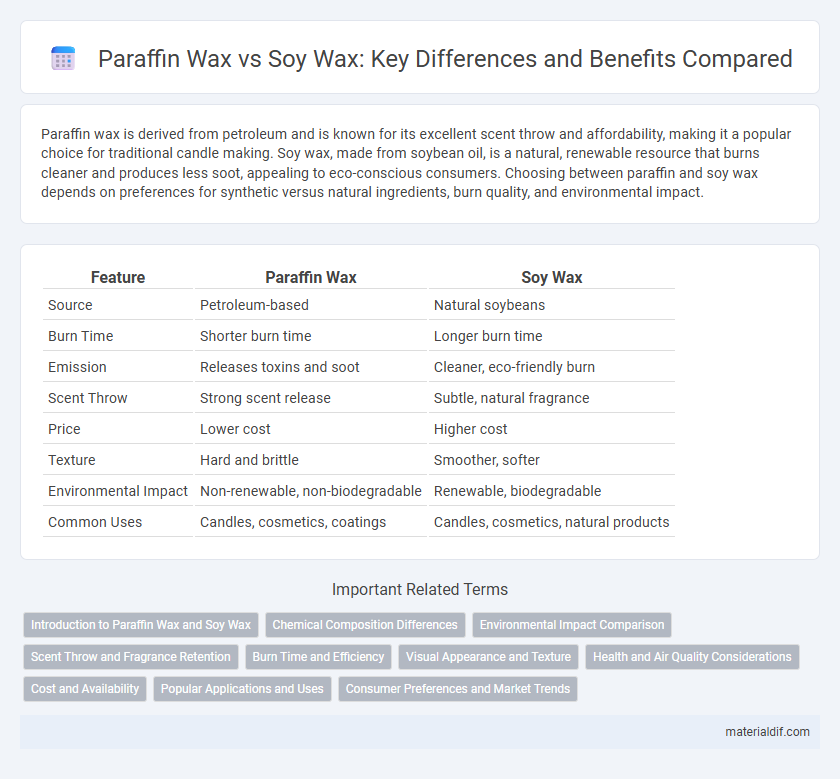Paraffin wax is derived from petroleum and is known for its excellent scent throw and affordability, making it a popular choice for traditional candle making. Soy wax, made from soybean oil, is a natural, renewable resource that burns cleaner and produces less soot, appealing to eco-conscious consumers. Choosing between paraffin and soy wax depends on preferences for synthetic versus natural ingredients, burn quality, and environmental impact.
Table of Comparison
| Feature | Paraffin Wax | Soy Wax |
|---|---|---|
| Source | Petroleum-based | Natural soybeans |
| Burn Time | Shorter burn time | Longer burn time |
| Emission | Releases toxins and soot | Cleaner, eco-friendly burn |
| Scent Throw | Strong scent release | Subtle, natural fragrance |
| Price | Lower cost | Higher cost |
| Texture | Hard and brittle | Smoother, softer |
| Environmental Impact | Non-renewable, non-biodegradable | Renewable, biodegradable |
| Common Uses | Candles, cosmetics, coatings | Candles, cosmetics, natural products |
Introduction to Paraffin Wax and Soy Wax
Paraffin wax, derived from petroleum refining, is a widely used, affordable option known for its smooth texture and excellent scent retention in candles. Soy wax, made from hydrogenated soybean oil, is a natural, renewable resource favored for its clean burning, longer-lasting, and eco-friendly properties. Comparing paraffin wax and soy wax helps consumers choose based on factors such as sustainability, scent throw, and burn quality.
Chemical Composition Differences
Paraffin wax, derived from petroleum, primarily consists of saturated hydrocarbons known as alkanes, which contribute to its solid, crystalline texture and higher melting point. Soy wax is made from hydrogenated soybean oil, containing triglycerides that provide a softer texture and a cleaner, longer-lasting burn due to its natural fatty acid esters. The chemical composition differences influence their environmental impact, scent throw, and melting behavior in candle making.
Environmental Impact Comparison
Paraffin wax, derived from petroleum, releases harmful chemicals and carbon emissions when burned, contributing to air pollution and environmental degradation. Soy wax, made from renewable soybean oil, offers a biodegradable and cleaner-burning alternative with lower greenhouse gas emissions. Choosing soy wax supports sustainable agriculture and reduces reliance on fossil fuels, promoting better air quality and ecosystem health.
Scent Throw and Fragrance Retention
Paraffin wax offers a strong scent throw and excellent fragrance retention, making it ideal for delivering vibrant and long-lasting aromas. Soy wax provides a softer scent throw but excels in slow, steady fragrance release, promoting a more subtle and enduring scent experience. Both waxes differ significantly in their ability to disperse and retain fragrances, with paraffin favoring intensity and soy focusing on longevity.
Burn Time and Efficiency
Paraffin wax typically offers a longer burn time due to its higher melting point, making it more efficient for extended use compared to soy wax. Soy wax burns cleaner and at a cooler temperature, which can enhance scent throw but often results in a shorter overall burn duration. Choosing between paraffin and soy wax depends on the desired balance between burn longevity and natural, eco-friendly qualities.
Visual Appearance and Texture
Paraffin wax features a smooth, glossy finish and a firm texture, providing a classic, polished look in candle making. Soy wax has a creamier, opaque appearance with a softer, more pliable consistency that creates a natural, rustic aesthetic. Both waxes offer distinct visual and tactile qualities suited to different candle styles and preferences.
Health and Air Quality Considerations
Paraffin wax, derived from petroleum, emits volatile organic compounds (VOCs) and soot particles when burned, potentially impacting indoor air quality and respiratory health. Soy wax, a natural, biodegradable alternative made from soybean oil, burns cleaner with minimal soot and lower VOC emissions, making it a healthier choice for indoor use. Choosing soy wax candles can reduce exposure to harmful pollutants and improve overall air quality in living spaces.
Cost and Availability
Paraffin wax is generally more affordable and widely available due to its petroleum-based production, making it a cost-effective choice for large-scale candle manufacturing. Soy wax, derived from soybean oil, tends to be pricier because of its renewable sourcing and variable crop yields, impacting price stability and availability. Despite higher costs, soy wax offers an eco-friendly alternative with increasing market presence driven by consumer demand for sustainable products.
Popular Applications and Uses
Paraffin wax is widely used in candle making due to its excellent fragrance retention and smooth finish, making it a popular choice for decorative and scented candles. Soy wax, derived from soybean oil, is favored for eco-friendly applications such as container candles and massage bars because of its natural, renewable source and cleaner burn. Both wax types are also utilized in food packaging and cosmetics, but soy wax is increasingly preferred for sustainable and allergen-sensitive products.
Consumer Preferences and Market Trends
Paraffin wax remains popular due to its affordability and strong scent throw, appealing to consumers seeking budget-friendly candles with intense fragrances. Soy wax gains preference among eco-conscious buyers for its renewable origin, cleaner burn, and longer-lasting qualities, aligning with increasing demand for sustainable products. Market trends indicate a growing shift towards soy wax as environmental awareness rises, while paraffin wax maintains a strong position in mass-market and fragrance-focused segments.
Paraffin wax vs Soy wax Infographic

 materialdif.com
materialdif.com